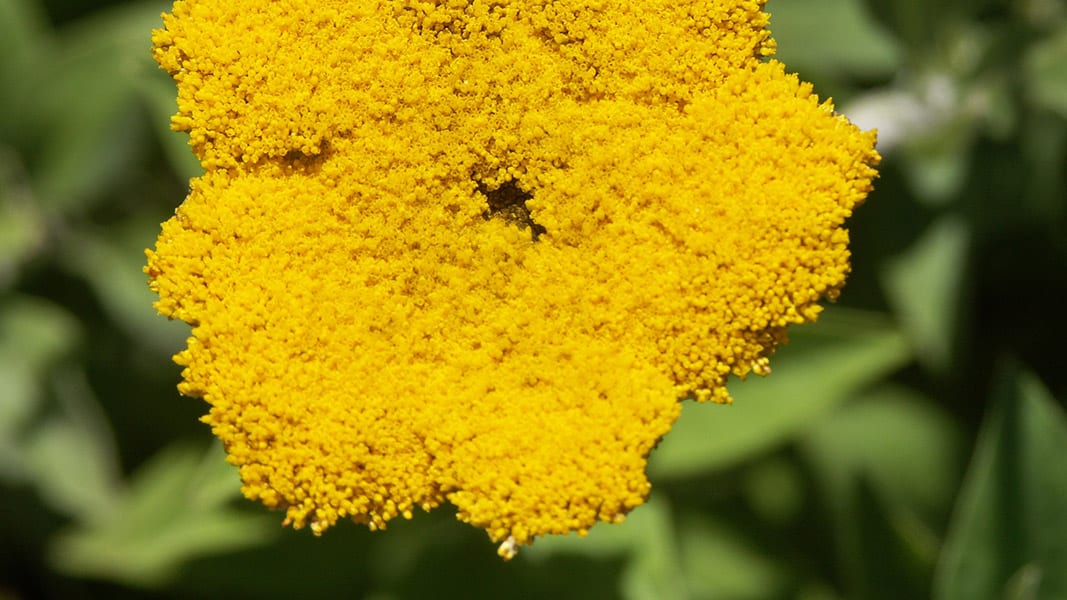
18 May Finding Rare Cannabinoids in Non-Cannabis Plants

Special glands protruding from cannabis flowers express a series of unique molecules. Cannabinoids, as they are known, exist in cannabis. But it turns out that identical molecules are present in non-cannabis plants, as well. Researchers from Israel’s Weizmann Institute recently reported that they found cannabigerolic acid (CBGA) and other rare cannabinoids in Helichrysum umbraculigerum, a perennial shrub informally known as the woolly umbrella.1
A South African Botanical
Ferdinand Bohlmann and Evelyn Hoffman first discussed the chemical irregularity of Helichrysum. In a 1979 paper published in Phytochemistry2, they analyzed the South African species H. umbraculigerum, native to the eastern part of the country, where it was used in traditional medicine and fumigation rituals.
Bohlmann and Hoffman asserted that the plant’s tops — both leaves and flowers — produce cannabis-specific compounds. But a follow-up study conducted by Italian researchers in 2017 failed to find CBG or its acidic precursor in H. umbraculigerum flowers. They did, however, identify an analog of CBG known as Heli-CBG (also present in some fiber hemp varietals), which binds to the CB2 cannabinoid receptor.3,4
In a May 2023 article in Nature Plants, Weissman Institute scientists confirmed that woolly umbrella produces CBGA in trichomes on its leaves, but hardly any CBGA was present on its flowers. That’s different from cannabis, where CBGA and other cannabinoids are concentrated in trichomes on flower tops.1
Trichomes found on cannabis inflorescence (flowers) have a special cellular build, according to a 2022 study by University of British Columbia researchers in Current Biology. The gland’s bulbous head holds large porous cells that let acidic cannabinoids (CBGA, CBDA, THCA, etc.) move through the trichome.5 The Weizmann Institute team reported that H. umbraculigerum produces a similar cannabinoid transport network on its leaves.1
Sourcing Rare Cannabinoids in Non-Cannabis Shrubs
How did the Israeli scientists figure this out? They fed woolly umbrella precursor compounds responsible for making cannabinoids in cannabis. When given two precursors (hexanoic acid and phenylalanine), the shrub produced more cannabinoids compared to plants fed regular nutrients. This means that the same biosynthetic pathway exists in both cannabis flowers and woolly umbrella leaves.
The woolly umbrella shrub naturally produces on its leaves over 4% cannabigerolic acid alongside other rare cannabinoids. The shrub also contains water-soluble cannabinoids, which are not found in cannabis.
Essentially, two different plant species have developed the same machinery to produce CBGA. Yet, woolly umbrella is evolutionarily distinct from cannabis. And unlike the shrub, cannabis makes two unique enzymes that flip CBGA into either THCA and/or CBDA.
Exploring a New Phytocannabinoid Toolkit
Thus, there are two toolboxes for cannabinoid phyto-synthesis in the phylogenetic tree. Terpenes and a few flavonoids accompany lipophilic cannabis flowers, whereas a complex array of flavones and water-soluble cannabinoids develop in H. umbraculigerum. By understanding their similarities and differences, we can better assess the therapeutic potential of each plant.
Cannabinoid compounds found in woolly umbrella dissolve more easily in water and can target specific areas of the body, such as the deeper bowel. But greater bioavailability, an argument for water-soluble cannabinoids, is not necessarily equivalent to greater potency. That which is absorbed quickly and easily also leaves the body and loses efficacy faster. And cannabinoid receptors have more affinity for fat-loving compounds compared to water-soluble agonists.6,7
Travis Cesarone is a freelance writer and communicator focusing on medical cannabis sciences. © Copyright, Project CBD. May not be reprinted without permission.
References
- Berman, P., de Haro, L.A., Jozwiak, A. et al. Parallel evolution of cannabinoid biosynthesis. Nat. Plants (2023).
- Cannabigerol-ähnliche verbindungen aus Helichrysum umbraculigerum. Phytochemistry. 1979;18(8):1371-1374.
- Pollastro, F., De Petrocellis, L., Schiano-Moriello, A., Chianese, G., Heyman, H., Appendino, G., & Taglialatela-Scafati, O. (2017). Amorfrutin-type phytocannabinoids from Helichrysum umbraculigerum. Fitoterapia, 123, 13–17.
- Pollastro F, Taglialatela-Scafati O, Allarà M, Muñoz E, Di Marzo V, De Petrocellis L, Appendino G. Bioactive prenylogous cannabinoid from fiber hemp (Cannabis sativa). J Nat Prod. 2011 Sep 23;74(9):2019-22. doi: 10.1021/np200500p. Epub 2011 Sep 8. PMID: 21902175.
- Livingston, S. J., Rensing, K. H., Page, J. E., & Samuels, A. L. (2022). A polarized supercell produces specialized metabolites in cannabis trichomes. Current biology : CB, 32(18), 4040–4047.e4. https://doi.org/10.1016/j.cub.2022.07.014
- Li, X., Chang, H., Bouma, J. et al. Structural basis of selective cannabinoid CB2 receptor activation. Nat Commun 14, 1447 (2023).
- Stadel, R., Ahn, K. H., & Kendall, D. A. (2011). The cannabinoid type-1 receptor carboxyl-terminus, more than just a tail. Journal of neurochemistry, 117(1), 1–18. https://doi.org/10.1111/j.1471-4159.2011.07186.x


Sorry, the comment form is closed at this time.